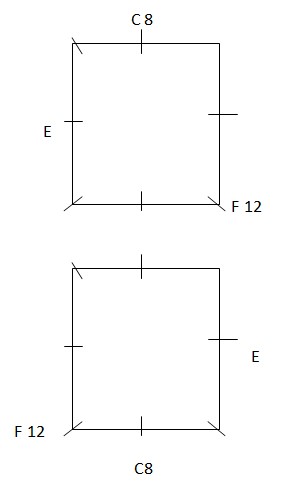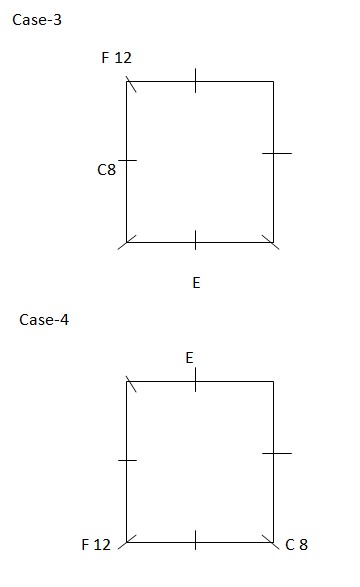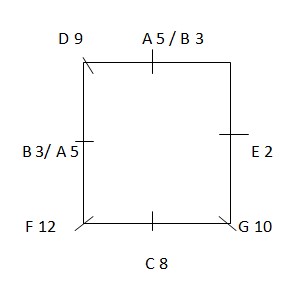Question
Who among the following is
youngest? Answer the questions based on the information given below. There are 7 persons A, B, C, D, E, F and G sitting around square table, where four of them were sitting in the middle of the edges and three are sitting at the corners. Each of them is of different ages among- 2, 3, 5, 8, 9, 10 and 12. Each of them is facing towards the center of the table. E, who is sitting at the edge, is sitting second to the right of C, who is 8 years old. F, who is the oldest person, is sitting three places away from E and is sitting at the corner. G, who is 1 year elder than D, is sitting opposite to D. A is 2 years elder than B, and both of them are either sitting at the corner or at the edge. A and G are not immediate neighbors.Solution
E is sitting at the edge and 2nd to the right of C. C is 8 years old. F, who is the oldest person, is sitting three places away from E and is sitting at the corner. So, E is sitting at the edge which means we have four possible places for E. Case-1 
 G, who is 1 year elder than D, is sitting opposite to D. A is 2 years elder than B, and both of them are either sitting at the corner or at the edge. A and G are not immediate neighbors. Now, G is sitting opposite to D which is not possible in case I and III so, these cases are rejected. Also, in case IV, if we place G and D opposite then we can’t place A and B on the same side of the table so, case IV is also rejected. A must be 5 years old and B must be 3 years old also, D must be 9 years old which means G is 10 years old. Then final arrangement is shown below:
G, who is 1 year elder than D, is sitting opposite to D. A is 2 years elder than B, and both of them are either sitting at the corner or at the edge. A and G are not immediate neighbors. Now, G is sitting opposite to D which is not possible in case I and III so, these cases are rejected. Also, in case IV, if we place G and D opposite then we can’t place A and B on the same side of the table so, case IV is also rejected. A must be 5 years old and B must be 3 years old also, D must be 9 years old which means G is 10 years old. Then final arrangement is shown below: 
Twenty five liters of 60% concentration of acid solution is added to 35 liters of 80% concentration of acid solution. What is the concentration of acid ...
A circular park is having the circumference of 110m. A uniform path of width 3.5m has been made around the park. Find the area of this path?
In an exam of 100 marks, the average marks of a class of 38 students are 72. If the top 3 scorers of the class leave, the average score falls “dow...
The measure of an angle is one-third of its supplementary angle. Find its measure.
- The area of the base of a rectangular reservoir is 960 m² and the volume of water contained in it is 38400 m³. Find the depth of the water in the reservo...
There is a rectangular paper, whose length and breadth are in the ratio 7:8, respectively and it has a perimeter of 60 metres. If a triangular piece wit...
The volume and height of a cylinder are 2662 cm3 and 7 cm. Find the radius of the cylinder.
Find the length of a wire radius 0.40 cm which can completely cover the surface of a cylinder whose height is 1.6m and base radius 21 cm?
The radius of a right circular cylinder is 3 times its height. If the height of the cylinder is 3.5 cm, then what is the volume of the cylinder. (in cub...
A cuboidal room has a length of 28 metres and a width of 16 metres. The volume of air in the room is 2240 cubic metres. What will be the cost of paintin...
Relevant for Exams:


